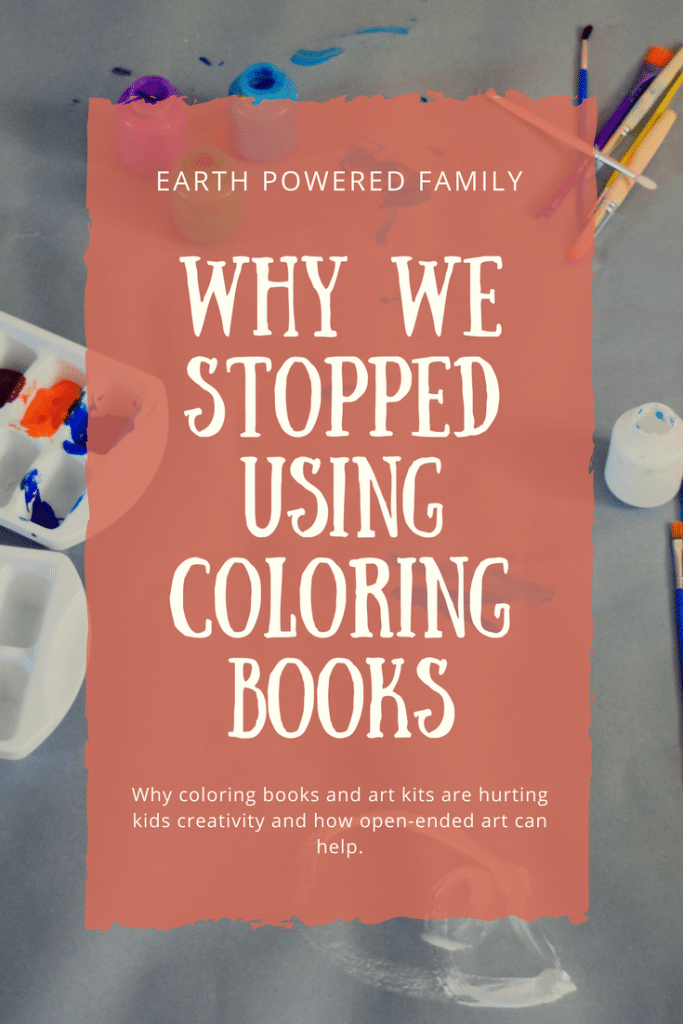My 3 year old (soon to be 4!) struggled with art for quite some time. He constantly asked other people to do the drawing for him and seemed to be afraid to try anything with explicit instructions. We had a fully stocked creative space complete with paints, crayons, paper, ribbon, glue, etc. But nothing was being used unless he had an adult there to walk him through every step (or just do it for him).
In hindsight, this was entirely my fault. Although I had provided opportunities for open-ended art, the majority of his “creative” time was spent with coloring books or the predetermined art kits with step by step directions and a specific outcome. I would leave a coloring book and some markers on his table, thinking that I was providing him with the option to do art any time he wanted. More importantly, it was a way for me to get some time to throw in a load of laundry or cook a meal. Like every other overtired and stressed parent, I overused an entertainment method because it worked. But what I was actually doing was hurting his creativity.
But they’re just coloring books!
There’s nothing inherently wrong with a coloring book or an art kit but they really don’t offer a whole lot to the child. Sure, a coloring book can keep a kid occupied and many parents worry about whether or not their child can “color inside the lines”. But what does something like this offer a child’s creativity? How does it inspire creative thinking? Problem solving? What does it tell a child about their own artwork if they are being shown how a particular piece of art needs to turn out?
This is why I think my son was so afraid to create an artwork with no directions, no pre-made picture, and no help. So, I banned them from our creative space. And it was the best decision I’ve made for fostering my child’s creativity.
How will children learn how to color inside the lines?
I’ve heard this concern time and time again, and of all the concerns about a child’s education, this was an odd one. Coloring inside the lines suggests that a child has learned two things: how to follow directions and improved fine motor skills. But there are many other ways to help children with these two concerns, without teaching them that their drawing should look a particular way.
Children are learning how to follow directions just by being parented. This is also something they get plenty of in school. And when it comes to fine motor skills, any other activity that involves the hands and fingers suffices just fine. Some fine motor boosting activities include: stringing beads, playing with clay, cooking, puzzles, playing with blocks, etc.
Here’s what coloring books and art kits actually teach:
A coloring book and an art kit have a specific outcome. A coloring page will generally look the same no matter how it’s colored, especially if children “follow the rules” and color in the “correct” colors. The same goes for art kits; there are pre-made pieces that go together in a way the directions tell them to. The outcome is extremely specific. Kids are learning not how to create, but how someone else thinks art should look. Plus, most coloring books are filled with characters from movies and television shows, only adding to an environment packed with commercials and consumerism.
Do I ban coloring books and art kits completely?
No, these things are super handy when traveling or when I need my child to be occupied. But, I treat screens the same way. Because they are not beneficial, just entertaining, I treat them as such. But of course, there’s never harm in handing a child a coloring book every now and then. It can be troublesome when it’s constant, like junk food and television.
How do we foster creativity?
The answer is simple: Open-Ended Art! Open-ended art is exactly what the name suggests; it’s art with no specific outcome and no step-by-step directions. It can be super open-ended when we let the child choose the medium, subject, and time spent on it or we can lend a gentle hand by providing an open invitation to create with a specific tool such as crayons and watercolor or paint and paper.
I’ve talked about the value of open-ended play and how it nurtures creativity and helps a child’s brain to develop. But open-ended art is just as important, particularly because as adults, their society will need more creative thinkers and innovators. Psychologists are finding that creativity among children is sharply declining, which is alarming in an increasingly competitive and oversaturated market.
The idea is that children are naturally creative and by letting them explore this creativity without an adult telling them how something should look, this creativity can grow and improve.






